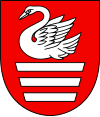Bilgoraj
| Biłgoraj | |||
|---|---|---|---|

Polish Baroque Church of the Assumption of Mary, early 17th century, Biłgoraj
|
|||
|
|||
 |
|||
| Coordinates: 50°33′N 22°44′E / 50.550°N 22.733°E | |||
| Country |
|
||
| Voivodeship | Lublin | ||
| County | Biłgoraj County | ||
| Gmina | Biłgoraj (urban gmina) | ||
| Established | 1578 | ||
| Town rights | 1578 | ||
| Government | |||
| • Mayor | Janusz Zbigniew Rosłan | ||
| Area | |||
| • Total | 20.85 km2 (8.05 sq mi) | ||
| Elevation | 212 m (696 ft) | ||
| Population (2014) | |||
| • Total | 27,106 | ||
| • Density | 1,300/km2 (3,400/sq mi) | ||
| Time zone | CET (UTC+1) | ||
| • Summer (DST) | CEST (UTC+2) | ||
| Postal code | 23-400 to 23-401 | ||
| Area code(s) | (+48) 84 | ||
| Car plates | LBL | ||
| Website | http://www.bilgoraj.pl | ||
Biłgoraj [bʲiwˈɡɔraj] (Yiddish: בילגאריי, Bilgoray, Ukrainian: Білґорай) is a town in south-eastern Poland with about 27,100 inhabitants (2014). Since 1999 it has been situated in Lublin Voivodeship; it was previously in Zamość Voivodeship (1975–1998). It is located south of Lublin and it is also the capital of Biłgoraj County. Historically, the town belongs to Lesser Poland, and is located in southeastern corner of the province, near the border with another historic land, Red Ruthenia. Biłgoraj is surrounded by forest, with three rivers flowing through it.
The name of the town comes from a hill called Biely Goraj, on which Biłgoraj was founded in the 16th century. Biłgoraj lies in northern part of Sandomierz Basin, near . The town is surrounded by Solska Wilderness, not far away (20 km (12 mi)) from . Administratively, since 1474 it has been tied with the city of Lublin. In that year, Lublin Voivodeship was split away from Sandomierz Voivodeship. An average July temperature in Biłgoraj is 18 °C (64 °F), an average January temperature −2.8 °C (27.0 °F). The town is crossed by four small rivers: Biala Lada, Czarna Lada, Osa and Próchnica. Biłgoraj lies on the elevations ranging from 190 to 205 meters above sea level. The area of the town is 20 square kilometres (8 square miles), of which forests covers 9%. Built-up area stretches along eastern bank of the Biala Lada, for 5 km (3 mi) (north–south) and 3 km (2 mi) (west–east).
The area of current Biłgoraj was covered by dense forests and swamps, where establishment of human settlements was difficult. In the first half of the 16th century, local noble family of Gorajski built first settlements in this sparsely populated corner of Lesser Poland. At that time, the villages of Gromada, Dabrowica and Olendrów were founded.
...
Wikipedia



